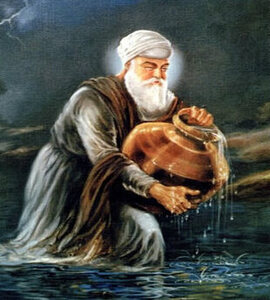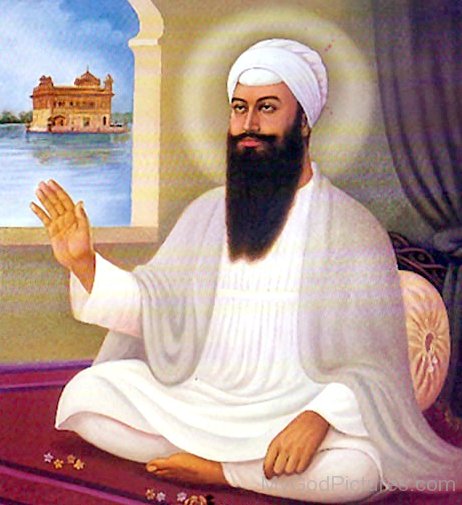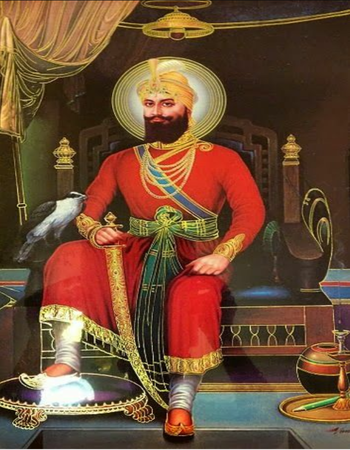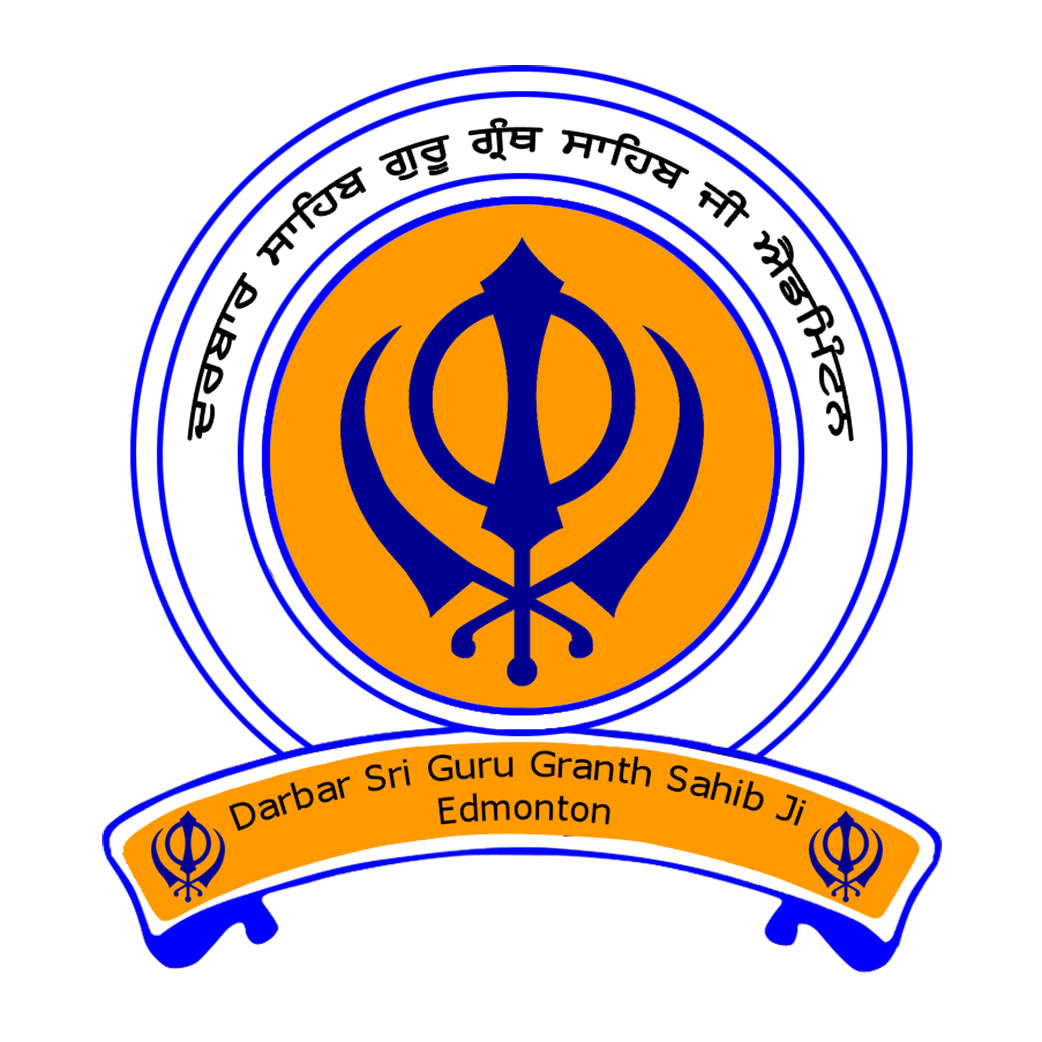The Sikh Gurus are the spiritual masters of Sikhi, who established this religion over the course of about two and a half centuries, beginning in 1469. The year 1469 marks the birth of Guru Nanak, the founder of Sikhism. He was succeeded by nine other gurus until, in 1708, the Guruship was finally passed on by the tenth guru to the holy sikh scripture, Guru Granth Sahib, which is now considered the living Guru by the followers of the Sikh faith.
Sri Guru Nanak Dev Ji
Sri Guru Nanak Dev Ji (the First Nanak, the founder of Sikhism) was born on 15th April, 1469 at Rai-Bhoi-di Talwandi in the present district of Shekhupura (Pakistan), now Nanakana Sahib. The Birthday of Guru Nanak Sahib is celebrated on 15th Kartik Puranmashi i.e. full moon day of the month Kartik. On this day the Birthday of Sri Guru Nanak Dev Ji is celebrated every year. (But some other chronicals state that Sri Guru Nanak Dev Ji was born on 20th October,1469) Guru Nanak’s father, Mehta Kalyan Das, more popularly known as Mehta Kalu was the agent and Chief Accountant of Rai Bular. Sri Guru Nanak Dev Ji ‘s mother was Mata Tripta, a simple, pious and extremely religious woman. Nanak had an elder sister, Nanki, who always cherished her younger brother.

Sri Guru Angad Dev Ji
Sri Guru Angad Dev Ji, (Bhai Lahna ji) was born in the village named Sarai Naga (Matte Di Sarai) district Muktsar (Punjab), on Vaisakh Vadi 1st , (5th Vaisakh) Samvat 1561, (March 31, 1504). He was the son of a petty trader named Pheru ji. His mother ‘s name was Mata Ramo ji (also Kwown as Mata Sabhirai, Mansa Devi, Daya kaur). Baba Narayan Das Trehan was his grand father, whose ancestral house was at Matte-di-Sarai near Mukatsar. Pheru ji shifted back to this place.Death and successorSri Guru Angad Dev Ji, (Bhai Lahna ji) was born in the village named Sarai Naga (Matte Di Sarai) district Muktsar (Punjab), on Vaisakh Vadi 1st , (5th Vaisakh) Samvat 1561, (March 31, 1504). He was the son of a petty trader named Pheru ji. His mother ‘s name was Mata Ramo ji (also Kwown as Mata Sabhirai, Mansa Devi, Daya kaur). Baba Narayan Das Trehan was his grand father, whose ancestral house was at Matte-di-Sarai near Mukatsar. Pheru ji shifted back to this place.

Sri Guru Amardas Sahib Ji
Sri Guru Amardas Ji, the Third Nanak was born at village Basarke Gillan in Amritsar district on Vaisakh Sudi 14th, (8th Jeth), Samvat 1536 (5th May 1479). (Some chronicles mention the month of April 1479). His father Tej Bhan Bhalla and mother Bakht Kaur (also reffered as Sulakhani and Lakhmi Devi) were orhtodox Hindus and used to pay annual visits to the Ganges river at Haridwar. Sri Guru Amardas Ji was married to Mata Mansa Devi ji and had four childern: two daughters; Bibi Dani ji and Bibi Bhani ji (she was married to Sri Guru Ramdass Ji), and two sons; Mohan ji and Mohri ji.

Sri Guru Ramdas Sahib Ji
Sri Guru Ramdas Ji (Jetha ji) was born at Chuna Mandi, Lahore (in Pakistan), on Kartik Vadi 2nd, (25th Assu) Samvat 1591 (September 24, 1534). Son of Mata Daya Kaur ji (Anup Kaur ji) and Baba Hari Das ji Sodhi Khatri was very handsome and promising child. His parents were too poor to meet even the daily needs and he had to earn his bread by selling boiled grams. His parents died when he was just 7 year old. His grandmother (mother’s, mother) took him to her native village Basarke. He spent five years at village Basarke earning his bread by selling boiled grams. According to some chronicles, once Sri Guru Amardas Ji came village Basarke to condole with the grandmother of Sri Guru Ramdas Ji at the death of her son-in-law and developed deep affection for Sri Guru Ramdas Ji. Along with grandmother he left for Goidwal Sahib to settle there. There he resumed his profession of selling boiled grams and also began to take part in the religious congregation held by Sri Guru Amardas Ji. He also made active participation in the development of Goindwal Sahib.

Sri Guru Arjan Dev Ji
Sri Guru Arjan Dev Ji, the youngest son of Sri Guru Ramdas Ji and Mata Bhani Ji was born at Goindwal Sahib on Vaisakh Vadi 7th, (19th Vaisakh) Samvat 1620 (April 15,1563). He learnt Gurmukhi script and Gurbani from Baba Budha ji. He was also given a suitable education in Persian, Hindi and Sanskrit languages. The child (Guru)Arjan Sahib often talked of God and loved to sing His songs. He had two elder brothers, Prithi Chand ji and Mahadev ji. The former proved to be the most selfish and the later mostly preferred utter silence. But (Guru) Arjan Dev Ji was sweet, humble and a perfect blend of devotion and sacrifice.

Sri Guru Hargobind Sahib Ji
Sri Guru Hargobind Sahib Ji was born at village Guru Ki Wadali (district Amritsar) on Harh Vadi 7th (21 Harh), Samvat 1652 (19th June, 1595). He was extremely handsome and the only son of Guru Arjan Sahib and Mata Ganga Ji. He had one daughter Bibi Viro Ji and five sons: Baba Gurditta Ji, Suraj Mal Ji, Ani Rai Ji, Atal Rai Ji and (Guru) Tegh Bahadur Ji. Out of these, four sons passed away during the life of Guru Sahib and the fifth one, Sri Guru Tegh Bahadur Ji become Ninth Nanak in 1664. Sri Guru Hargobind Sahib Ji succeeded Guru Arjan Sahib in 1606, at the age of eleven years. After the martyrdom of Sri Guru Arjan Dev Ji, the moment was crucial for the Sikhs. Now for the first time, the Sikhs began to think seriously to counter the high-handedness of the mighty and theist Muslim Empire. Now a change had taken place in the character of Sikh Nation on the force of circumstances. Dialectically speaking, it was the need of the hour. Now the Sikh nation adopts both spiritual and political ways simultaneously. This policy suited well to all the social and economic segments of the Sikhs.

Sri Guru Har Rai Ji
Guru Har Rai was born to Nihal Kaur and Baba Gurditta into a Sodhi household. His father died while he was 8 years old. At age 10, in 1640, Guru Har Rai was married to Mata Kishan Kaur (sometimes also referred to as Sulakhni) the daughter of Daya Ram.They had two children, Ram Rai and Har Krishan, the latter of whom became the eighth Guru.J. S. Grewal (1998).Guru Har Rai had brothers. His elder brother Dhir Mal had gained encouragement and support from Shah Jahan, with free land grants and Mughal sponsorship. Dhir Mal attempted to form a parallel Sikh tradition and criticized his grand father and sixth Guru Hargobind.

Sri Guru Har Krishan Ji
Har Krishan was born in Kiratpur (Shivalik Hills) in northwest Indian subcontinent to Krishen Devi (Mata Sulakhni) and Guru Har Rai. His father, Guru Har Rai supported the moderate Sufi influenced Dara Shikoh instead of conservative Sunni influenced Aurangzeb as the two brothers entered into a war of succession to the Mughal Empire throne.After Aurangzeb won the succession war in 1658, he summoned Guru Har Rai in 1660 to explain his support for the executed Dara Shikoh. Guru Har Rai sent his elder son Baba Ram Rai to represent him. Aurangzeb kept the 13 year old Ram Rai as hostage, questioned Ram Rai about a verse in the Adi Granth – the holy text of Sikhs. Aurangzeb claimed that it disparaged the Muslims.

Sri Guru teg bahadur Ji
Tegh Bahadur was the youngest son of Guru Hargobind, the sixth guru: Guru Hargobind had one daughter, Bibi Viro, and five sons: Baba Gurditta, Suraj Mal, Ani Rai, Atal Rai and Tyaga Mal. Tyaga Mal was born in Amritsar in the early hours of 1 April 1621. Hecame to be known by the name Tegh Bahadur (Mighty of the Sword), given to him by Guru Hargobind after he had shown his valour in a battle against the Mughals.Amritsar at that time was the centre of Sikh faith. As the seat of the Sikh Gurus, and with its connection to Sikhs in far-flung areas of the country through the chains of Masands or missionaries, it had developed the characteristics of a state capital. Tegh Bahadur was brought up in Sikh culture and trained in archery and horsemanship.

Sri Guru Gobind Singh Ji
Gobind Singh was the only son of Guru Tegh Bahadur, the ninth Sikh guru, and Mata Gujri. He was born in Patna on 22 December 1666, Bihar in the Sodhi Khatri family while his father was visiting Bengal and Assam.His birth name was Gobind Rai, and a shrine named Takht Sri Patna Harimandar Sahib marks the site of the house where he was born and spent the first four years of his life. In 1670, his family returned to Punjab, and in March 1672 they moved to Chakk Nanaki in the Himalayan foothills of north India, called the Sivalik range, where he was schooled.His father Guru Tegh Bahadur was petitioned by Kashmiri Pandits in 1675 for protection from the fanatic persecution by Iftikar Khan, the Mughal governor of Kashmir under Mughal Emperor Aurangzeb.

